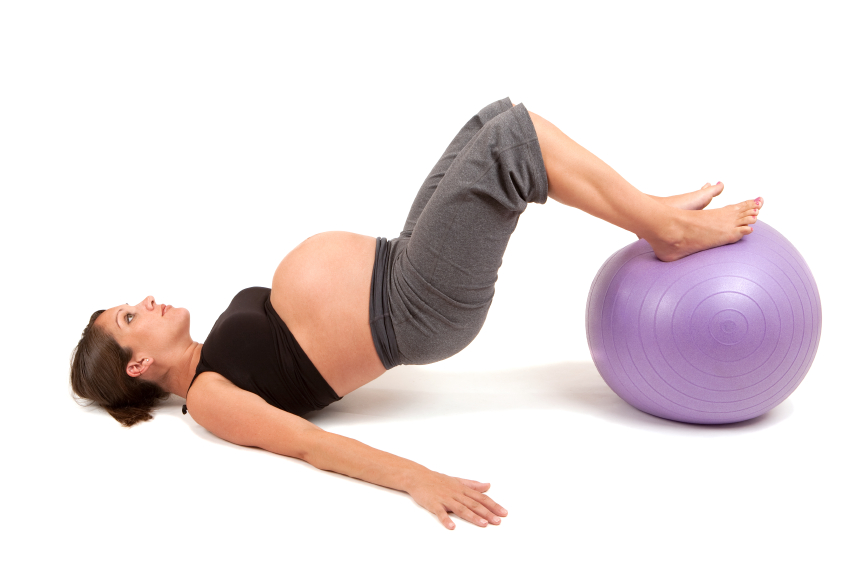
Being fit doesn’t have to mean a big time commitment or fancy equipment. The following workout is simple, can be done at home, and is safe to do in each trimester.
Pregnant women who exercise have less back pain, more energy, a better body image and, post-delivery, a faster return to their pre-pregnancy shape.
Experts recommend that you exercise for 30 minutes a day, on most days. Most exercises are safe to perform during pregnancy, as long as you exercise with caution and do not overdo it.
Aerobic Pregnancy Exercises
All of these cardiovascular exercises increase blood circulation, muscle tone and endurance (which you’ll be thankful for come delivery day):
Swimming
Swimming and water aerobics may just be the perfect pregnancy workout. Why? In the water you weigh a tenth of what you do on land, so you’ll feel lighter and more limber. A dip in the pool may also help relieve nausea, sciatic pain and puffy ankles — and because baby’s floating along with you, it’s gentle on your loosening joints and ligaments (your body’s natural response to pregnancy hormones).
Brisk walking
There’s no easier exercise to fit into your busy schedule than walking…and it’s a workout you can continue to fit in right up until delivery date (and even on D-day if you’re anxious to help the contractions along). What’s more, you don’t need any special equipment or a gym membership to participate — just some good sneakers. If you opt for a hike, be sure to avoid uneven terrain (especially later in pregnancy, when your belly can block your view of that rock in your path), high altitudes and slippery conditions.
Running
Want to go a little faster? Experienced runners can stay on track during pregnancy. Just stick to level terrain (or a treadmill or an elliptical machine) and never overdo it (loose ligaments and joints during pregnancy can make jogging harder on your knees — and make you more prone to injury).
Group dance or aerobics classes
Low-impact aerobics and dance workout classes are a great way to increase your heart rate and get the endorphins flowing if you’re a newbie exerciser. As your abdomen expands, avoid any activities that require careful balance. If you’re an experienced athlete, just be sure to listen to your body and never exercise to the point of exhaustion.
Indoor cycling
A wonderful way to break a sweat without putting pressure on your ankle and knee joints, indoor cycling lets you pedal at your own pace without the risk of falling. Try transitioning your cardio workouts to a stationary bike, or hop into an indoor cycling class for a more structured ride. (Just make sure your instructor knows you’re expecting, and feel free to sit out sprints and hills if you feel overheated or exhausted at any point.)
If you’re an avid outdoor cycler, talk to your doctor about whether it’s safe to continue bicycling outdoors after getting pregnant (and if, at some point, you should stop). The extra weight of your baby belly can affect your balance, and you don’t want to risk toppling over when baby is on board.
Strength and Flexibility
The following strength workouts help maintain and build your muscles. In turn, stronger and more flexible muscles help you to bear the weight you gain throughout your pregnancy and protect your joints from injuries as your ligaments relax:
Weight lifting
Lifting weights is safe when you’re expecting — just opt for more reps (i.e., 12 to 15 in a set) using a lower weight than usual. You might also want to switch to machines, which helps limit your range of motion and reduces any chance of injury (be sure to stretch when you’re done!). Also be sure to limit isometric movements (exercises where you hold still in a particular position): If you accidentally forget to breathe in this position (it’s a common mistake!), you could easily become lightheaded.
Pilates
A pregnancy-appropriate Pilates routine focuses mainly on strengthening your core and lengthening your muscles. And all that core strengthening will help ease backaches and improve your posture (which you’ll also be grateful for as your belly gets bigger) as well as your flexibility (which comes in handy during labor).
Prenatal Yoga
Prenatal yoga is another ideal workout for the mama-to-be: It encourages relaxation, flexibility, focus and deep breathing — all great preparation for the marathon of birth. Look for a class specifically tailored for pregnant women, or ask your regular yoga instructor to modify the poses so that they’re safe for you. Just avoid Bikram yoga (the kind done in a hot room), since you need to pass on exercises that heat you up too much.
Pregnancy Exercises Ball
Choosing the Right Exercise Ball
Doing fitness ball activities effectively requires careful selection of a quality ball with the correct size. When selecting a ball, look for the following:
- Professional-quality, burst-resistant material that easily inflates. Some balls with deflate slowly if torn or punctured, giving you time to get off the ball safely.
- An easy-to-use inflatable pump and extra stoppers.
- The correct size ball for your body: If you’re shorter than five feet three inches, you’ll need a 55 cm ball; if you’re taller than five feet three inches, look for a 65 cm ball.
Many fitness balls are sold with exercise videos. Be sure to look for a good pregnancy fitness routine to guide you through safe postures and exercises.
Tips for Exercising With a Ball
- Make sure that the inflation hole plug is firmly pressed all the way into the ball.
- Exercise on a carpet or a surface where the ball won’t roll out from under you. If you have a wood floor, place a nonslippery mat under the ball (a sticky yoga mat is great) or wear exercise shoes that grip well.
- Wear snug, comfortable exercise clothes; loose shorts can stick to the ball and be uncomfortable.
- If you need extra support to steady yourself, keep a sturdy chair nearby to hold onto when necessary.
- Stop if you feel any discomfort during exercise.
- Drink plenty of water during and after exercise.
- Make sure your ball is at the best degree of inflation for you (see “Inflating the Ball”).
- Stick with this program, even after the baby is born, and it will help with your postpartum recovery.
When to Stop Exercising
You should stop exercising if you:
- feel queasy
- get too hot
- feel dehydrated
- experience any vaginal discharge, bleeding, or abdominal or pelvic pain
Hydrate regularly during pregnancy whether you’re exercising or not. There isn’t any recommendation for the ideal heart rate during first trimester exercise, but a good rule of thumb is that you should be able to have a normal conversation while you’re working out.

